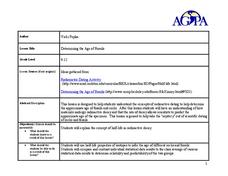Curated OER
Family Pedigrees
Pupils work as a class to first construct a pedigree of a popular singer, showcasing the singing gene being passed down through the generations. Students then make their own family pedigree and follow two traits through their family lines.
Curated OER
Relationships, Rules, and Responsibilities
First graders identify jobs in the environment. In this social justice lesson, 1st graders describe rules to protect the environment and the roles specific jobs play. Students construct environmental rules for an imaginary town.
Core Knowledge Foundation
Third Grade Skills Unit 11: Introduction to Ecology
The concluding skills unit offers learning opportunities and reviews in preparation for assessments. Scholars participate in lessons that examine spelling patterns, prefixes, suffixes, pronouns, and adjectives, draft a letter, and listen...
Core Knowledge Foundation
Third Grade Skills Unit 7: What’s in Our Universe?
Over four weeks, third graders participate in lessons that boost spelling, grammar, reading, and writing skills. Scholars explore spelling patterns, suffixes, singular and plural possessive nouns, quotations, and conjunctions....
National Center for Case Study Teaching in Science
In Sickness and in Health
Based on family history, how likely is it that a couple's children will have a recessive disease? In an in-depth, but easy-to-follow case study, future geneticists learn the story of Greg and Olga, who are hoping to have children, but...
Curated OER
Energy Safety Tips
Students explore hazards of both electricity and natural gas when they are not properly handled. Students investigate the real-world hazards electricity and natural gas present. They participate in a simulation that illustrates the flow...
Curated OER
Dino-Mite Web Quest
In this science worksheet, students identify a specific dinosaur to research. Then they develop an overview of their dinosaur family and the foods each dinosaur in their family eat. Students also identify how the dinosaurs defend...
Curated OER
Organic Chemistry-Naming Hydrocarbons
In this naming hydrocarbons worksheet, students are given a table of the prefixes used for naming hydrocarbons based on the number of carbon atoms and their location. They then practice naming ten hydrocarbon compounds using the rules of...
Curated OER
Genetics the Easy Way
Students use recyclable trash to construct a Recycle Critter family. They calculate the probability of the phenotype of the offspring that two heterozygous parents produced.
Curated OER
Conceptualizing an Experiment
Students work together to design an experiment. They discover the origin of a family artifact. They analyze the data and discuss the results. They determine if the experiment is the best way to find out this type of information.
Curated OER
The Use of Myths in Science
Students are told stories, myths and legend to explain their world. After telling the tales and discussion them, students are assigned to write a myth that describes a familiar situation, such as why the school garbage cans are always...
Curated OER
Fruit or Vegetable?
Watermelon is a vegetable? A tomato is a fruit? Believe it or not, this debate is decades old. Groups examine rulings by the US Supreme Court, the USDA, and state statutes before developing their own criteria to use when labeling the...
Curated OER
Introduction to Welding
Students explore how to weld and the safety procedures that are in place. In this welding lesson students take a safety test on welding and once they know all the rules they use the angle grinder.
Curated OER
What is in a Name?
Students examine taxonomy and the use of dichotomous keys through two activities. They use a dichotomous key and create one of their own as well as create new scientific Family names for penguins using same word roots used by taxonomists.
Curated OER
Watch the Sky for Lightning
Students identify lightning in pictures from the provided Internet site. They study a definition of lightning as a form of heat energy that can be dangerous. They state and illustrate a minimum of three lightning safety rules.
Curated OER
Friendly Feud
Young scholars play a "Family Fued"-type game, answering teacher-prepared questions, to review for any of the content areas.
Curated OER
Predicting: Making a Hypothesis
Students analyze information from various sources to create a hypothesis about the origin of a family artifact. Students create a hypothesis about the origin of the item and write a paragraph explaining why they believe the hypothesis is...
Curated OER
Chemistry
In this chemistry worksheet, students describe an atom, its parts, the charges of these parts, and atoms life functions. Then they explain what the octet rule states for the placements of electrons around the nucleus of an atom. Students...
Curated OER
Wild, Wild Weather: Severe Storms
Second graders research dangerous weather and how they can stay safe. In this environment lesson, 2nd graders view video clips and research the Internet to identify the different types of severe weather storms. Students complete a...
Curated OER
Classifying Living Things
Learners identify how to classify living things. They classify various concepts including family members, kinds of clothing, numbers, shapes, and vocabulary words. They discuss how to classify various concepts and classify pictures of...
Curated OER
Determining the Age of Fossils
Students examine the concept of radioactive dating. In this radioactive dating lesson plan, students investigate how to determine the ages of fossils and rocks as they learn about half-life radioactive decay.
Curated OER
Regulation and handling of animal products: a special challenge
Students examine how food safety affects sustainable animal production and marketing. In this agriculture lesson students complete several activities including one on groceries and the rules of animal products.
Curated OER
Oxyanions
In this oxyanions worksheet, students identify the common polyatomic ions. They write formulas and name polyatomic ions based on IUPAC rules.
Curated OER
Testing the Hypothesis
Students create and conduct various experiments to determine the origin of a family artifact, and then determine whether their results were successful. Students summarize their results and evaluate whether their hypotheses were correct.

























